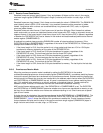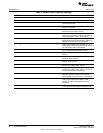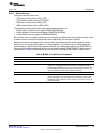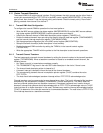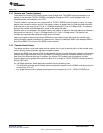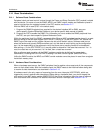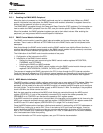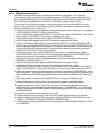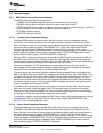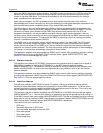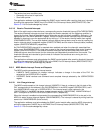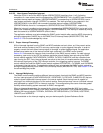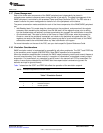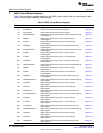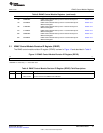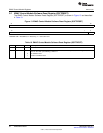
www.ti.com
Architecture
2.16 Interrupt Support
2.16.1 EMAC Module Interrupt Events and Requests
The EMAC module generates 26 interrupt events:
• TXPENDn: Transmit packet completion interrupt for transmit channels 0 through 7
• RXPENDn: Receive packet completion interrupt for receive channels 0 through 7
• RXTHRESHPENDn: Receive packet completion interrupt for receive channels 0 through 7 when flow
control is enabled and the number of free buffers is below the threshold
• STATPEND: Statistics interrupt
• HOSTPEND: Host error interrupt
2.16.1.1 Transmit Packet Completion Interrupts
The transmit DMA engine has eight channels, with each channel having a corresponding interrupt
(TXPENDn). The transmit interrupts are level interrupts that remain asserted until cleared by the CPU.
Each of the eight transmit channel interrupts may be individually enabled by setting the appropriate bit in
the transmit interrupt mask set register (TXINTMASKSET) to 1. Each of the eight transmit channel
interrupts may be individually disabled by clearing the appropriate bit by writing a 1 to the transmit
interrupt mask clear register (TXINTMASKCLEAR). The raw and masked transmit interrupt status may be
read by reading the transmit interrupt status (unmasked) register (TXINTSTATRAW) and the transmit
interrupt status (masked) register (TXINTSTATMASKED), respectively.
When the EMAC completes the transmission of a packet, the EMAC issues an interrupt to the CPU (via
the EMAC control module) when it writes the packet’s last buffer descriptor address to the appropriate
channel queue’s transmit completion pointer located in the state RAM block. The interrupt is generated by
the write when enabled by the interrupt mask, regardless of the value written.
Upon interrupt reception, the CPU processes one or more packets from the buffer chain and then
acknowledges an interrupt by writing the address of the last buffer descriptor processed to the queue’s
associated transmit completion pointer in the transmit DMA state RAM.
The data written by the host (buffer descriptor address of the last processed buffer) is compared to the
data in the register written by the EMAC port (address of last buffer descriptor used by the EMAC). If the
two values are not equal (which means that the EMAC has transmitted more packets than the CPU has
processed interrupts for), the transmit packet completion interrupt signal remains asserted. If the two
values are equal (which means that the host has processed all packets that the EMAC has transferred),
the pending interrupt is cleared. The value that the EMAC is expecting is found by reading the transmit
channel n completion pointer register (TXnCP).
The EMAC write to the completion pointer actually stores the value in the state RAM. The CPU written
value does not actually change the register value. The host written value is compared to the register
content (which was written by the EMAC) and if the two values are equal then the interrupt is removed;
otherwise, the interrupt remains asserted. The host may process multiple packets prior to acknowledging
an interrupt, or the host may acknowledge interrupts for every packet.
The application software must acknowledge the EMAC control module after processing packets by writing
the appropriate CnRX key to the EMAC End-Of-Interrupt Vector register (MACEOIVECTOR). See
Section 5.12 for the acknowledge key values.
2.16.1.2 Receive Packet Completion Interrupts
The receive DMA engine has eight channels, which each channel having a corresponding interrupt
(RXPENDn). The receive interrupts are level interrupts that remain asserted until cleared by the CPU.
Each of the eight receive channel interrupts may be individually enabled by setting the appropriate bit in
the receive interrupt mask set register (RXINTMASKSET) to 1. Each of the eight receive channel
interrupts may be individually disabled by clearing the appropriate bit by writing a 1 in the receive interrupt
mask clear register (RXINTMASKCLEAR). The raw and masked receive interrupt status may be read by
reading the receive interrupt status (unmasked) register (RXINTSTATRAW) and the receive interrupt
status (masked) register (RXINTSTATMASKED), respectively.
51
SPRUFL5B–April 2011 EMAC/MDIO Module
Submit Documentation Feedback
© 2011, Texas Instruments Incorporated



